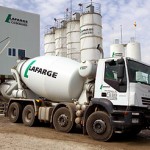Shimla: Cement major Lafarge suffered a major setback for setting up a cement plant at Alsindi in Mandi district after the National Environment Appellate Authority (NEAA) revoked the environment clearance that was granted by the central government.
The NEAA judgment was delivered after the one-man team, consisting of NEAA Chairman JC Kala made an on the spot inspection at the plant and mine site in June 23.
Local people and environmental groups had petitioned NEAA, after the company had managed to get the all important environment clearance from the central government on 8th June, 2009.
The Himachal government had approved the 3 million tons per annum Greenfield cement plant to the French conglomerate on 25th September 2006 in the hope of attracting Rs 900 Crore investments for the proposed captive mine plant at Alsindi.
Environmentalists Manshi Asher and Prakash Bhandari, who have been opposing the cement plant said that NEAA judgment spells out the adverse implications of the project and also points towards the faulty and inadequate Environment Impact Assessment done for the project plans.
NEAA is an appellate body that hears public grievances against environmental clearances handed out by the ministry of environment and forestry.
However, a Lafarge spokesman maintained that the company was not violating environment norms and disturbing the ecological balance in the area.

He said manufacturing at the site would be undertaken through a dry process technology using minimal water and based on zero-discharge concept. Any surplus waste water would be treated and solid waste from treatment plant would be disposed off in an environmentally sound manner.
Lafarge India Pvt Ltd., is a subsidiary of the French giant, which happens to be the world’s second largest cement company in the world.
As Editor, Ravinder Makhaik leads the team of media professionals at Hill Post.
In a career spanning over two decades through all formats of journalism in Electronic, Print and Online Media, he brings with him enough experience to steer this platform. He lives in Shimla.





the judgement against the installation of cement plant passed by the NEAA is a milestone for the protection of Environment in himachal pradesh. I can say there are honest officers still in India just like Mr. J.C.Kala. I wish to solute Mr. J.C.Kala for the delievery of such type of judgement.
All rubbish… Ask from the young generation… Lack of industrial growth has always been an issue in himachal forcing himachalis to work in other states … Hp needs such factories so that both skilled & unskilled workers can work in himachal itself and also to make hp at par with other states who are making big sums from industrial growth like gujrat… Hp has the potential to be both .. A tourism industry and an industrial hub .. So cement plants like lafarge should be welcomed in hp…
If “health of the people” near the cement industries is an area of concern then instead of barring cement & other industries , alcohol & cigarette manufacturing industries should be barred instead..
i agree we need industrial development but not at the cost of environment and people who are residing there ..we flaunt many environment concerns on the name of development ..when in real sense the development is just mirage.nd mind u these are capitalist who are least concerned about what their profit bring harm to people around. and our politician hv joined hands with them to earn their share of bad money..
All young genration are against the cement plant
my dear frnds those days had gone that cement plant has only dust, it has completely changed the scenrio, just giv a luk to cement plants which r better than chemical industry.
and lastly dont forget for employment.
kyun laat mar rahe ho unhe jo cement mein kaam karete hai,
Great News! But this victory can not be triumph unless the government works out the employment alternatives to the locals. Ot else, it risks giving handle to the lobbyists and “sold-out” guys who would take to streets for depriving people of the livelihood.